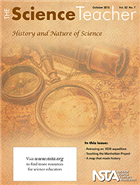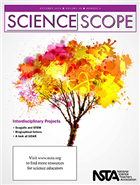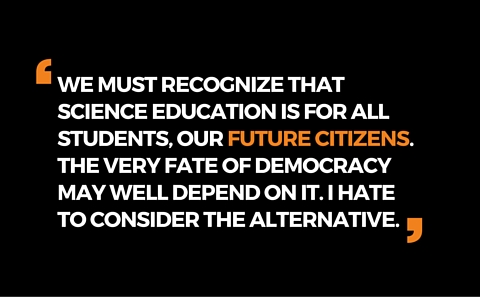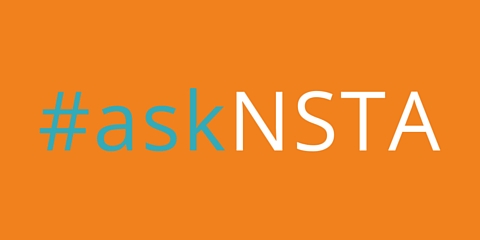Ideas from NSTA's October K–12 journals
By Mary Bigelow
Posted on 2015-10-18
Each of the K-12 journals this month includes DCIs, SEPs, and CCs, Oh My! Understanding the Three Dimensions of the NGSS with in-depth descriptions of what the Disciplinary Core Ideas, Science and Engineering Practices, and Cross-cutting concepts mean for science curriculum, instruction, and assessment. A must read!
The themes of the three K-12 Journals in October fit together nicely – the History and Nature of Science lends itself to interdisciplinary studies, and studying the earth provides a context for these studies.
 The Science Teacher: History and Nature of Science
The Science Teacher: History and Nature of Science
The featured articles focus on how historical events and discoveries connect with scientific knowledge and how this knowledge changes with new events and discoveries. See this month’s Science Scope for more lessons on the interdisciplinary Nature of Science.
- Teaching the Manhattan Project describes an interdisciplinary unit that examines the relationship between discoveries in science and the development of nuclear weapons.
- William Smith’s Mapping Milestone – Last summer, I had the opportunity to see Smith’s geologic map of Great Britain at the Geological Society in London. The 100-year old map is amazing in its size, detail, and importance. This article focuses on how “Interactive Historical Vignettes” (including one based on this map) can be used to help students understand the nature of science.
- Chemical Solitaire – Students use element cards to explore patterns among elements and how to organize them as new elements are added to the mix.
- A Cool Controversy – Glaciers are used as a historical context for learning current concepts. Students make and use models of glaciers and photos of student work are included.
- Are We Alone in the Universe? – Recent discoveries on Mars have raised interesting possibilities. This article describes how the SOURCES framework can be used to integrate primary sources into science investigations. The article includes links to some of these sources.
- Idea Bank: Exploring the History of Science With Movies Liven up student learning about scientists and their work with video segments. The article includes sources for brief, focused video segments as well as suggestions for using them in the classroom.
- Career of the Month: Science and Technology Librarian The Smithsonian recently had an article on the “death” of the card catalog. Find out what a 21st century science librarian does and why their jobs are important.
- Safer Science: Safety in the Field Be sure to read NSTA’s Safety Advisory Board’s white paper on Field Trip Safety, described in and linked from this article.
Here are some SciLinks with content information and suggestions for additional activities and investigations related to this month’s featured articles: Glaciers, Ice Ages, Life on Other Planets, Nuclear Reactions, Our Universe, Periodic Table.
Continue for Science and Children and Science Scope.
 Science and Children: Earth’s Systems
Science and Children: Earth’s Systems
This issue focuses on Systems, with examples from earth science, specifically related to climate and weather. Although many elementary students study the weather, understanding how weather and climate are related (and changing) is important for students. As the editor notes, “The core ideas should begin with place-based weather concepts and then expand to global climates.”
- Speleothems and Sand Castles – Students can study the formation of stalagmites and stalactities in the classroom.
- Using Models Scientifically – Kick up the study of the water cycle to incorporate more about using models.
- From Droughts to Drones – Students study local situations using current technology.
- Animal Detectives – How do animals, specifically wolves, relate to and interact with their habitat?
- NGSS in Action – Studying soil provides a context for English Language Learners.
- Teaching Through Trade Books: Wonderful Water – The two lessons here focus on the role of water in earth processes.
- The Early Years: About the Weather – Our youngest students can learn to document local weather and look for patterns.
- Formative Assessment Probes: Wet Jeans – What do students understand (or misunderstand) about the water cycle, including evaporation and condensation.
- Engineering Encounters:
Nature as Inspiration – How can a study of plant structures lead to ideas for collecting and storing water?
Here are some SciLinks with content information and suggestions for additional activities and investigations related to this month’s featured articles: Caverns, Drought, Groundwater, Landforms, Soil, Weather, Water Conservation, Water Cycle, Wolves.
Science Scope: Interdisciplinary Projects
“Viewing similar content from multiple perspectives can enhance learning, produce a greater depth of understanding, and foster creativity and insight,” according to the editor. Many of these articles also address the Nature of Science, the theme of The Science Teacher.
- Using a STEM-Based Approach to Make Recycling Metallic Elements Relevant has suggestions for an interdisciplinary investigation into properties of metals and the costs and logistics of recycling them.
- See Less Sea-Less Seagulls: Planning for an Interdisciplinary STEM Unit describes an extended interdisciplinary project and the planning and preparation it required.
- Connecting the Dots: Lasers Link Students to Their 3-D World has suggestions for building and using a 3-D mapping instrument.
- Shrimp and Black Gill: Studying the Effect of Apostome Ciliates includes resources for a role-playing game that simulates ecological relationships and interactions.
- Using Biographical Letters to Draw on the Nature of Science shows how writing and science can be integrated into a study of the history and nature of science with classroom examples.
- Tried and True: Using Observations of Fossils to Reconstruct Ancient Environments – Not all science investigations are experiments. This article shows how students can conduct observations of fossils and derive conclusions from them.
- Teacher’s Toolkit: Bridging the Three Dimensions of the NGSS Using the Nature of Science describes how to adapt a lesson to incorporate the nature of science. The sample lesson is one on exploring the features of the ocean floor.
Here are some SciLinks with content information and suggestions for additional activities and investigations related to this month’s featured articles: Ciliophora, Crustaceans, Fossil Record, Fossils, Landforms, Lasers, Ocean Floor, Metals, Recycling, Scientists’ Biographies, Sonar.
Each of the K-12 journals this month includes DCIs, SEPs, and CCs, Oh My! Understanding the Three Dimensions of the NGSS with in-depth descriptions of what the Disciplinary Core Ideas, Science and Engineering Practices, and Cross-cutting concepts mean for science curriculum, instruction, and assessment. A must read!
Heredity and Variation
Can Science Teachers Save Our Democracy?
By David Evans, NSTA Executive Director
Posted on 2015-10-14
A few months ago, I started to write an op-ed with the statement that science teachers are saving our democracy. Why do I believe this? Because science teachers provide the tools our children need to remain well-informed, participatory citizens. Jefferson said, “Whenever the people are well-informed, they can be trusted with their own governance.” Today there are (well-financed) anti-science campaigns against teaching evolution or teaching about climate change that represent serious threats to the very basis of our democracy. The only viable defense against these threats is scientific literacy, and the defensive lineup consists of science teachers. “Scientific” knowledge, shared among all citizens, should be the basis for public policy as opposed to an appeal to “revealed knowledge” or authority.
Recently, while looking through old books at the local library book sale, I came across the Winter 1940 volume of Science and Society. The lead article underscored the role of science teachers as critical links in preserving democracy. J. D. Bernal, one of the fathers of crystallography, wrote “Science Teaching in General Education” and much of it sounds as if it were written yesterday afternoon. He presaged the Next Generation Science Standards (NGSS) when he said:
The old methods of teaching, with their formal approach, and their rigid separation between science and the humanities, are plainly incompetent to deal with these developments [the development of the importance of science]. The attempt to apply them results in parrot-like learning, in a stifling of intelligence and criticism, and in the production of individuals who know so little of the major factors affecting their lives that they are more at the mercy of demagogues and quacks than an illiterate population…. The reform of education is not a luxury; it is a necessity if we are to safeguard existing democracy.
And speaking of traditional science education, Bernal goes on:
At its worst, it simply handed out information that was so out of relation with life as to become meaningless and impossible to remember. The greatest defect of scientific education in the past has been its inability to transmit the most characteristic aspect of science, namely, its method. It is most important that all, and particularly those who are not continuing in scientific careers, should learn scientific method by practicing it.
And how did he characterize the objectives of science education?
The first objective is to provide enough understanding of the science in society to enable the great majority that will not be actively engaged in scientific pursuits to collaborate intelligently with who are, and to be able to criticize or appreciate the effect of science on society.
The second objective, which is not entirely distinct, is to give a practical understanding of the method of science [i.e., scientific practices] sufficient to be applicable to the problems that the citizen has to face in his individual and social life.
Finally, Bernal discusses the critical role of science teachers in achieving those objectives and the need for educators to use real-world problems to connect with their students and their community. Perhaps most importantly, he reflects on the role of the science teacher in the face of the “anti-scientific and anti-social forces [that] are powerfully entrenched in the school system.” The widespread adoption and implementation of NGSS by teachers, even in non-adopting states, is a testament to their enlightened commitment to reason.
Sadly, anti-scientific and anti-social forces are still powerfully entrenched in the school system. As we move ahead into the 2016 election season, and as we continue to address almost daily threats to the teaching of evolution and climate change, we must insist that our thought leaders are committed to supporting science education that emphasizes the practices of science over those hard to remember “facts.” We must recognize that science education is for all students, our future citizens. The very fate of democracy may well depend on it. I hate to consider the alternative.
 Dr. David L. Evans is the Executive Director of the National Science Teachers Association (NSTA). Reach him at devans@nsta.org or via Twitter @devans_NSTA.
Dr. David L. Evans is the Executive Director of the National Science Teachers Association (NSTA). Reach him at devans@nsta.org or via Twitter @devans_NSTA.
The mission of NSTA is to promote excellence and innovation in science teaching and learning for all.
Follow NSTA
Flow of Matter and Energy in Ecosystems
Earth, Sun, and Moon
Chemical Reactions
Teachers learning new content
By Mary Bigelow
Posted on 2015-10-14
 My background is in engineering and now I’m teaching middle school general science. I’m comfortable with the topics in physical and earth science, but I’m a little shaky on the life science topics, including cells, genetics, and evolution. Could you suggest some strategies or resources I could use to get up to speed quickly? —T., Minnesota
My background is in engineering and now I’m teaching middle school general science. I’m comfortable with the topics in physical and earth science, but I’m a little shaky on the life science topics, including cells, genetics, and evolution. Could you suggest some strategies or resources I could use to get up to speed quickly? —T., Minnesota
Teachers often find themselves reassigned to different subjects, and even the subjects we prepared for have ongoing discoveries and developments. Many of us can identify with your situation of keeping a few steps ahead of the students for a while (I was a chemistry major whose first teaching assignment was middle school life science).
For the content areas you identified in your question, here are several websites with information in a visual, understandable format (there are many others, of course):
- Learn Genetics has tutorials and readings on cell biology, genetics, neuroscience, human health, and ecology.
- Bozeman Science has brief videos geared toward high school students with good explanations of key concepts.
- Understanding Evolution has a collection of resources for students and teachers on the science and history of evolutionary biology.
Books geared for middle or high school students on the topics you’re discussing can provide a quick update at a level that your students will also understand. Check out the suggested reading lists in the NSTA journals or search the NSTA Recommends site.
Look for seminars or speakers at nearby colleges/universities. Professional societies., museums, zoos, nature centers, or botanical gardens often have lectures open to the public or special programs for teachers.
The resources at the NSTA Learning Center will help you, too. These resources include online web seminars and podcasts, as well as SciPacks. These collections of interactive, self-paced learning opportunities (called Science Objects) guide you through specific areas of science. In addition to the information you’ll learn, you also have access to an online mentor who can answer content questions for you. There are several related to life science, including Cell Structure and Function, Cell Division and Differentiation, Heredity and Variation, and Cells and Chemical Reactions.
Reading NSTA journals such as The Science Teacher, Science Scope, and Science & Children is an easy way to stay current, and your NSTA membership includes online access to all of them, including the archives. Even though you’re teaching middle school, the other two journals will have additional teaching ideas and content updates.
Participating a professional learning community through social media offers a just-in-time way to share ideas and information. NSTA has e-mail lists related to biology, middle school, and general science. NSTA also hosts discussion forums in life science and general science. Twitter has many hashtags for science teachers, including #nsta and #biologyteachers. In all of these resources, you’ll find colleagues are eager to offer just-in-time information, suggestions, and resources.
Check with your administrator to see if and how your independent studies could be considered part of your professional development plan.
With your expertise in engineering, you can be a resource for your colleagues as they learn more about the engineering practices in the Next Generation Science Standards (NGSS) and integrated science, technology, engineering, and mathematics (STEM) topics. You might be interested in the TeachEngineering site, in which topics and practices in life, earth and physical science are taught, connected, and reinforced through real-life problems or scenarios. There is an option to search the site by grade level, topic, and NGSS standards. The lessons have been designed by university engineering faculty and teachers. For example, Engineering and the Human Body illustrates the format and design of the units.
 My background is in engineering and now I’m teaching middle school general science. I’m comfortable with the topics in physical and earth science, but I’m a little shaky on the life science topics, including cells, genetics, and evolution. Could you suggest some strategies or resources I could use to get up to speed quickly? —T., Minnesota
My background is in engineering and now I’m teaching middle school general science. I’m comfortable with the topics in physical and earth science, but I’m a little shaky on the life science topics, including cells, genetics, and evolution. Could you suggest some strategies or resources I could use to get up to speed quickly? —T., Minnesota
Have a question about science teaching? #askNSTA
By Lauren Jonas, NSTA Assistant Executive Director
Posted on 2015-10-12
Bring your science teaching questions to the National Science Teachers Association (NSTA) this Fall. At our area conferences on science education in Reno, Philadelphia, and Kansas City, visit us at the #askNSTA booth in the exhibit hall or see what others are asking via Twitter using #askNSTA. Who will answer? Real people! Below are common reader questions. Read and learn more about us, and please send us questions when you have them.
Q. Who runs NSTA?
A. NSTA is supported by a staff that works to produce the materials you rely on–like our journals and conferences. They are guided by the NSTA Board of Directors and Council of District Directors, all of whom are science teachers and educators who have been elected by NSTA members. Read more about the Board and Council, and meet many of them at the NSTA Fall conferences at the #askNSTA booth in the exhibit hall.
 Join the NSTA governance! We are holding elections now and calling for volunteers for various committees, advisory boards, and review panels. Read more about how to get involved with NSTA. –NSTA President, Carolyn Hayes; follow Carolyn @caahayes
Join the NSTA governance! We are holding elections now and calling for volunteers for various committees, advisory boards, and review panels. Read more about how to get involved with NSTA. –NSTA President, Carolyn Hayes; follow Carolyn @caahayes
Q. I want to get my elementary students outside more. Do you have any suggestions?
A. I’m thrilled to answer this, because getting outside is every child’s right and has been linked to better attention in students. It’s a wonderful way to get them interested in science, improve their connection to the natural world, and keep them healthy. Creating a garden is one of our readers’ favorite ways to engage students in outdoor learning. There is a great conversation happening in the NSTA Learning Center Early Childhood Forum and an Early Years blog post is devoted to it (The Joys of Gardening with Young Children). To continue the connection with nature, read trade books with good science content, such as Nature in the Neighborhood by Gordon Morrison (HMHarcourt 2004), an NSTA Recommends resource.
 Use the CBC/NSTA yearly list of Outstanding Science Trade Books for Students K-12 and your local library to find great reading material. Science topics engage students and reach even your most reluctant readers. –Early education expert, Peggy Ashbrook; follow Peggy @PeggyAshbrook
Use the CBC/NSTA yearly list of Outstanding Science Trade Books for Students K-12 and your local library to find great reading material. Science topics engage students and reach even your most reluctant readers. –Early education expert, Peggy Ashbrook; follow Peggy @PeggyAshbrook
Q. I’m an NSTA member. What does that mean?
A. You’ve joined an amazing community of science educators who come together to share resources and information about how to bring the very best science learning to all students. Many of our members get their information through our journals. But at our core are people like the ones Caroline Hayes mentions above. Teaching is a challenging job, and having access to trusted resources and answers is something that our members tell us they like best.
 Read more about NSTA member benefits, and please feel free to get in touch with me at tbirts@nsta.org to let us know what you need or tell us how we’re doing. –-Teshia Birts, NSTA Senior Director of Membership; follow Teshia @TeshiaBirts
Read more about NSTA member benefits, and please feel free to get in touch with me at tbirts@nsta.org to let us know what you need or tell us how we’re doing. –-Teshia Birts, NSTA Senior Director of Membership; follow Teshia @TeshiaBirts
Q. How can I use Twitter in the classroom?
A. Twitter is an excellent way to build your professional learning network. I have compiled a playlist of Twitter videos you can use to get started. Because of the global nature of Twitter, I have been able use it to introduce my students to scientists from around the world. My students and I talk with scientists on Twitter every month using #SciStuChat in addition to smaller scale conversations in class daily/weekly.
 Recently we talked about a year in space. You can find the archive of the chat on scistuchat.com. You are welcome to join us in the future. –High school science teacher, Adam Taylor; follow Adam @2footgiraffe
Recently we talked about a year in space. You can find the archive of the chat on scistuchat.com. You are welcome to join us in the future. –High school science teacher, Adam Taylor; follow Adam @2footgiraffe
Q. How can I get funding to attend an NSTA conference?
A. That’s a great question and there are several ways we can help. First, all NSTA members get a great discount to all of our conferences and other resources. And look through our teacher awards–many of them give conference attendance as one of the prizes!
 At our conferences this Fall, we will be raffling off travel vouchers from Southwest Airlines at the #askNSTA booth. If you’ll be onsite, stop by and enter to win tickets to our national in Nashville this spring. –-Delores Howard, NSTA Assistant Executive Director, Conferences and Meetings
At our conferences this Fall, we will be raffling off travel vouchers from Southwest Airlines at the #askNSTA booth. If you’ll be onsite, stop by and enter to win tickets to our national in Nashville this spring. –-Delores Howard, NSTA Assistant Executive Director, Conferences and Meetings
The mission of NSTA is to promote excellence and innovation in science teaching and learning for all.
Future NSTA Conferences
2015 Area Conferences
2016 National Conference
2016 STEM Forum & Expo
Follow NSTA





